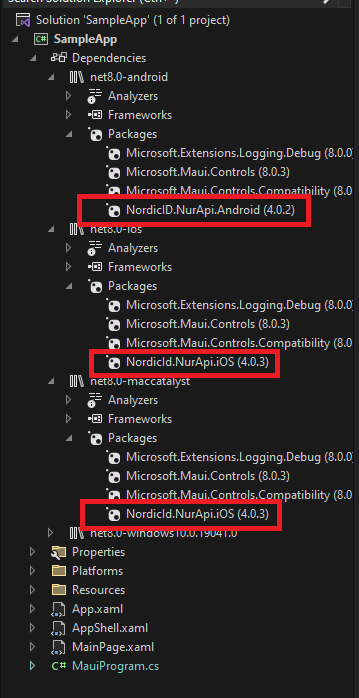.NET MAUI
Follow these simple steps below to integrate NurApi with your .NET MAUI project:
Step 1: Declare permissions
Before we can use functionality such as the device discovery, we have to declare some permissions first.
Note
- The following permissions are required to identify RFID readers connected via USB or Bluetooth Low Energy.
- Locate your AndroidManifest.xml at the Platforms/Android folder within your project and add the following permissions to the file:
<!-- Request legacy Bluetooth permissions on older devices. -->
<uses-permission android:name="android.permission.ACCESS_NETWORK_STATE" />
<uses-permission android:name="android.permission.ACCESS_COARSE_LOCATION" />
<uses-permission android:name="android.permission.ACCESS_FINE_LOCATION" />
<uses-permission android:name="android.permission.BLUETOOTH_PRIVILEGED" />
<uses-permission android:name="android.permission.BLUETOOTH" />
<uses-permission android:name="android.permission.BLUETOOTH_ADVERTISE" />
<uses-permission android:name="android.permission.BLUETOOTH_ADMIN" />
<uses-permission android:name="android.permission.BLUETOOTH_SCAN" />
<uses-permission android:name="android.permission.BLUETOOTH_CONNECT" />
<uses-feature android:name="android.hardware.bluetooth_le" android:required="true" />
<uses-feature android:name="android.hardware.usb.host" android:required="true" />
<uses-permission android:name="android.permission.USB_PERMISSION" />
Step 2: Installing NurApi & Support libraries
Next, you'll need to install the following NuGet packages. You can easily find and install them using the NuGet package manager in Visual Studio.
Note
Adding the packages at the Solution level allows you to add it to every target framework correctly in one step.
After the NuGet packages are installed, it should resemble the example below:

Step 3: Initializing the Support libraries
In .NET MAUI we can use a simple preprocessor compiler directive to initialize the
appropriate support library for each platform. Locate your MauiProgram.cs and find the function
CreateMauiApp(). Place this inside the function:
#if __ANDROID__
NurApiDotNet.Android.Support.Init(
Microsoft.Maui.ApplicationModel.Platform.AppContext);
#elif __IOS__ || __MACCATALYST__
NurApiDotNet.iOS.Support.Init();
#endif
When you are done, your CreateMauiApp() should resemble the following:
public static MauiApp CreateMauiApp()
{
#if __ANDROID__
NurApiDotNet.Android.Support.Init(
Microsoft.Maui.ApplicationModel.Platform.AppContext);
#elif __IOS__ || __MACCATALYST__
NurApiDotNet.iOS.Support.Init();
#endif
var builder = MauiApp.CreateBuilder();
builder
.UseMauiApp<App>()
.ConfigureFonts(fonts =>
{
fonts.AddFont("OpenSans-Regular.ttf", "OpenSansRegular");
fonts.AddFont("OpenSans-Semibold.ttf", "OpenSansSemibold");
});
#if DEBUG
builder.Logging.AddDebug();
#endif
return builder.Build();
}
Ready to Utilize NurApi
Congratulations! You're now fully equipped to leverage NurApi.